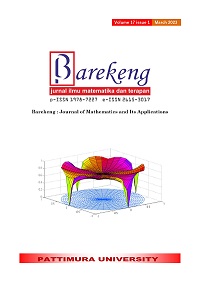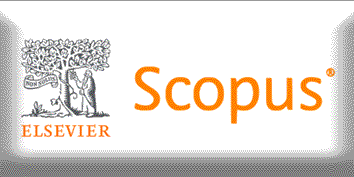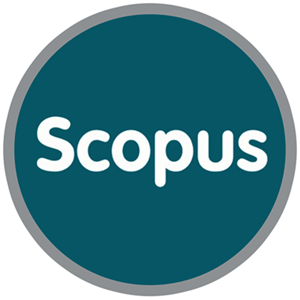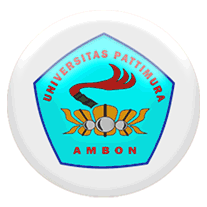SELECTION OF VIDEO CONFERENCE APPLICATION FOR MATHEMATICS LEARNING USING INTUITIONISTIC FUZZY MAX-MIN AVERAGE COMPOSITION METHOD
Abstract
In this article, the Intuitionistic Fuzzy Max-Min Average Composition method is used which aims to choose the right video conferencing application for learning mathematics. The results show that the learning process in Mathematical economics, Calculus, Statistics, and Geometry courses is more appropriate using the Microsoft Teams video conferencing application than Zoom and Google Meet.
Downloads
References
R. Wahyuni, E. Efuansyah, and S. Sukasno, “Developing Student Worksheet Based on Missouri Mathematics Project Model By Using Think-Talk-Write Strategy of Class Viii,” Infinity Journal, vol. 9, no. 1, p. 81, 2020, doi: 10.22460/infinity.v9i1.p81-92.
K. Kamaruddin, K. Kadir, and R. Ruslan, “Pengaruh Pembelajaran Kooperatif Tipe Jigsaw Kontekstual terhadap Kemampuan Koneksi Matematik Ditinjau dari Disposisi Matematik Siswa SMA,” Jurnal Pendidikan Matematika, vol. 9, no. 1, pp. 81–91.
Kementerian Pendidikan Dan Kebudayaan, “Pedoman Penyelenggaraan Belajar Dari Rumah Dalam Masa Darurat Penyebaran Corona Virus Disease (Covid-19),” Surat Edaran Nomor 15 Tahun 2O2O, 2020. https://www.kemdikbud.go.id/main/blog/2020/05/kemendikbud-terbitkan-pedoman-penyelenggaraan-belajar-dari-rumah
G. Basilaia and D. Kvavadze, “Transition to online education in schools during a SARS-CoV-2 coronavirus (COVID-19) pandemic in Georgia.,” Pedagogical Research, vol. 5, no. 4, 2020.
Y. Supriani and T. S. Hadi, “Conjecturing Ability Dalam Pembelajaran Daring Masa Pandemi Covid-19,” Inomatika, vol. 2, no. 2, pp. 161–169, 2020.
P. Z. Huzaimah, A. Risma, and R. Amelia, “Hambatan yang dialami siswa dalam pembelajaran daring matematika pada masa pandemi COVID-19,” Jurnal Cendekia: Jurnal Pendidikan Matematika, vol. 5, no. 1, pp. 533–541, 2021.
R. Andriyansah, A. N. Mu’arif, D. Nataliasari, and S. Rahmin, “Kesulitan Pembelajaran Daring Matematika Saat Pandemi COVID-19 Pada Siswa SMP Kelas VIII,” Jurnal Pendidikan dan Konseling (JPDK), vol. 3, no. 2, pp. 67–71, 2021.
K. Henra, N. Q. Tayibu, and I. N. Masliah, “Pengaruh Pembelajaran Daring Asynchronous Terhadap Tingkat Pemenuhan CPMK Statistika,” JIPM (Jurnal Ilmiah Pendidikan Matematika), vol. 10, no. 1, pp. 100–110, 2021.
A. H. Primandari and A. Kesumawati, “Meningkatkan Partisipasi Peserta Didik Menggunakan Problem Based Learning dan Strategi Blended Learning,” Refleksi Pembelajaran Inovatif, vol. 2, no. 2, Nov. 2020, doi: 10.20885/rpi.vol2.iss2.art2.
M. A. Abi Rowo, E. Suprapti, and H. Mursyidah, “Efektivitas Pembelajaran Daring Pada Mata Pelajaran Matematika,” APOTEMA: Jurnal Program Studi Pendidikan Matematika, vol. 8, no. 1, pp. 32–43, 2022.
K. Henra and I. N. Masliah, “Konflik Intrapersonal Siswa Dalam Belajar Matematika Secara Daring Synchronous,” AKSIOMA: Jurnal Program Studi Pendidikan Matematika, vol. 10, no. 3, pp. 1600–1610, 2021.
N. E. Ekawardhana, “Efektivitas pembelajaran dengan menggunakan media video conference,” in Seminar Nasional Ilmu Terapan, 2020, vol. 4, no. 1.
Y. Yusrianto and N. Hajeniati, “Deskripsi kualitas pembelajaran matematika dari penggunaan aplikasi zoom pada kelas VII,” Pythagoras: Jurnal Program Studi Pendidikan Matematika, vol. 11, no. 1, pp. 1–6, 2022.
J. W. Kusuma and H. Hamidah, “Perbandingan hasil belajar matematika dengan penggunaan platform Whatsapp Group dan webinar Zoom dalam pembelajaran jarak jauh pada masa pandemik Covid 19,” JIPMat, vol. 5, no. 1, 2020.
S. H. Muniroh, S. Rojanah, and S. Raharjo, “Efektivitas Pembelajaran Matematika Melalui Media Google Meet Ditinjau Dari Hasil Belajar Siswa Di Masa Pandemi Covid-19,” EDISI, vol. 2, no. 2, pp. 410–419, 2020.
A. Armiati and D. E. Febriani, “Analisis Pembelajaran Matematika Dengan Penggunaan Aplikasi Webinar Zoom Dalam Masa Pandemi Covid-19”.
L. A. Zadeh, “Fuzzy sets,” in Fuzzy sets, fuzzy logic, and fuzzy systems: selected papers by Lotfi A Zadeh, World Scientific, 1996, pp. 394–432.
K. T. Atanassov, “Intuitionistic fuzzy sets,” in Intuitionistic fuzzy sets, Springer, 1999, pp. 1–137.
P. A. Ejegwa, A. J. Akubo, and O. M. Joshua, “Intuitionistic fuzzy set and its application in career determination via normalized Euclidean distance method,” Eur Sci J, vol. 10, no. 15, 2014.
A. R. Wicaksono and R. Sulaiman, “Operasi Dan Relasi Pada Himpunan Fuzzy Intuisionistik,” MATHunesa, vol. 8, no. 2, pp. 69–78, 2020.
P. G. Sundari, P. Thiruveni, and A. M. Ali, “Application of Intuitionistic Fuzzy Sets In Decision Making Problem Using Revised Max-Min Composition Technique”.
A. E. Samuel and M. Balamurugan, “Fuzzy max-min composition technique in medical diagnosis,” Applied Mathematical Sciences, vol. 6, no. 35, pp. 1741–1746, 2012.
C. J. Eck, K. D. Layfield, C. A. DiBenedetto, and J. Gore, “School-Based Agricultural Education Teachers Competence of Synchronous Online Instruction Tools During the COVID-19 Pandemic.,” J Agric Educ, vol. 62, no. 2, pp. 137–147, 2021.
A. del Rio-Chillcce, L. Jara-Monge, and L. Andrade-Arenas, “Analysis of the Use of Videoconferencing in the Learning Process During the Pandemic at a University in Lima,” International Journal of Advanced Computer Science and Applications, vol. 12, no. 5, 2021.
Copyright (c) 2023 Kiki Henra, Efuansyah Efuansyah, Raden Sulaiman

This work is licensed under a Creative Commons Attribution-ShareAlike 4.0 International License.
Authors who publish with this Journal agree to the following terms:
- Author retain copyright and grant the journal right of first publication with the work simultaneously licensed under a creative commons attribution license that allow others to share the work within an acknowledgement of the work’s authorship and initial publication of this journal.
- Authors are able to enter into separate, additional contractual arrangement for the non-exclusive distribution of the journal’s published version of the work (e.g. acknowledgement of its initial publication in this journal).
- Authors are permitted and encouraged to post their work online (e.g. in institutional repositories or on their websites) prior to and during the submission process, as it can lead to productive exchanges, as well as earlier and greater citation of published works.






1.gif)



